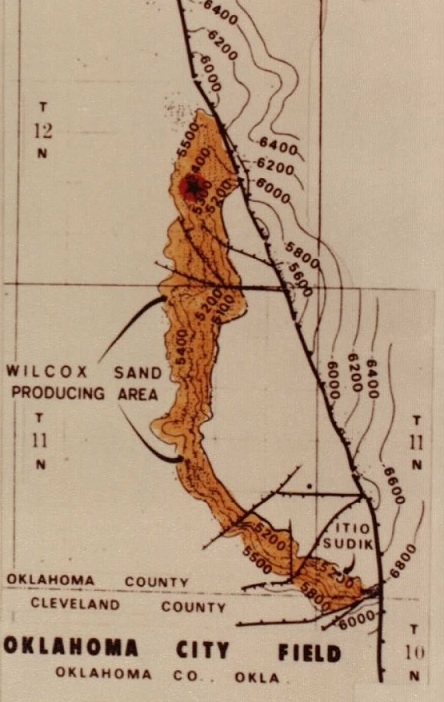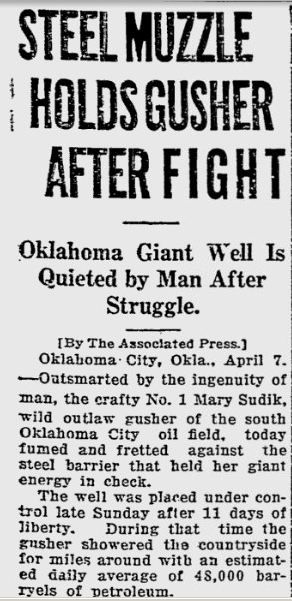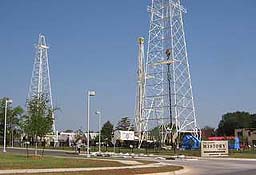“Clever equipment” controlled a 1930 Oklahoma City gusher featured in newsreels.
The Oklahoma geyser of “black gold” in 1930 was ideal for newsreels as the worst of the Great Depression loomed. NBC Radio rushed to cover the struggle to control the “Wild Mary Sudik” blow-out and gusher in the Oklahoma City oilfield. Within a week, repeated attempts to contain the well were making headlines.
The Mary Sudik No. 1 well erupted after striking a high-pressure formation about 6,500 feet beneath the Sudik farm. The Indian Territory Illuminating Oil Company’s well flowed for 11 days before being brought under control.
The well produced an astonishing 20,000 barrels of oil and 200 million cubic feet of natural gas a day — too much for the drilling technologies of the day. Efforts to tame “Wild Mary” became a public sensation.

“Wild Mary Sudik,” erupted in the Oklahoma City oilfield on March 26, 1930, and was regularly featured in theater newsreels. Crews recovered 200,000 barrels of oil from hastily constructed pits.
The attempts to control the wild well were regularly featured in newsreels and on radio, according to Oklahoma Journeys, a 2005 audio program at the Oklahoma History Center in Oklahoma City.
“At about 6:30 the morning of March 26, 1930, the crew of roughnecks drilling a well on the property of Vincent Sudik paused in their work,” the program begins about the well drilled near present day I-240 and Bryant Street in Oklahoma City. “The tired drillers had been waiting for daylight to continue their work.”
The crew was unfamiliar with the formation’s hazards, explains narrator Michael Dean, who says that after drilling to 6,471 feet, they overlooked signs of a dangerous pressure increase in the well. “The exhausted crew failed to fill the hole with mud.”
“They didn’t know the Wilcox Sand formation was permeated with natural gas under high pressure, and within minutes that sand under so much pressure found a release,” he added.

A circa 1940s map of the Oklahoma City oilfield shows the site of Mary Sudik No. 1 well in the Wilcox sands formation.
The drilling crew was caught off guard when oil and natural gas suddenly “came roaring out of the hole,” narrator Dean explained. “Pipe stems were thrown hundreds of feet into the air like so many tooth picks. First there was gas then the flow turned green gold and then black. Oil shot hundreds of feet into the air, and for the next eleven days, the Mary Sudik ran wild.”
Years earlier, as mid-continent oil and natural gas wells reached deeper depths by the early 1900s, highly pressurized formations in Kansas and the Indian Territory had challenged the petroleum industry’s well-control technologies.
In 1906, when lightning hit a natural gas well at Caney, Kansas, an uncontrollable flame could be seen for 35 miles (learn more in Kansas Gas Well Fire).
“Wild Mary Sudik” Daily Updates
Floyd Gibbons of NBC Radio — who regularly broadcasted about the Oklahoma City well — on April 6, 1930, reported that after two unsuccessful attempts, the roaring well finally was closed with a two-ton “overshot” cap.

Experts control the well with “a clever ball-shaped contrivance” that lowers a two-ton “overshot” cap.
An Associated Press article described the “clever equipment” required to control the well without sparking a fire — a “double die was screwed into four inches of casing threads…a clever ball-shaped contrivance, called a fantail, was used to affix the double die to the casing.”
The fantail was placed over the well, “and the ‘Wild Mary’s’ pressure, playing through jets in the contrivance, aided in lowering the cap through the blast,” the article explained.
“With the petroleum geyser halted, operators in the field drew sighs of relief,” it concluded. “A stray spark from two clanking pieces of steel and the territory might have become a raging inferno.”
With the well was brought under control and the danger of fire eliminated, drilling continues at a frantic pace elsewhere in Oklahoma City. But the extremely high-pressure of the Wilcox sands formation continued to challenge drillers and the industry technologies.
The Southwest Missourian newspaper reported:
Oklahoma City, April 7, 1930 — A gas well, estimated to be producing at a rate of 75,000,000 cubic feet a day, blew in at the edge of the city today, creating a new fire threat less than 24 hours after the wild No. 1 Mary Sudik gusher, several miles to the south, had been brought under control.
Recognizing the risks of drilling into the Wilcox sand, Oklahoma City passed additional ordinances for safety and well spacing in the city.
The first ram-type blowout preventer had been patented by James Abercrombie in 1926, but many high-pressure oilfields would take time to tame. In December 1933, he patented a greatly improved version that set a new standard for safe drilling during the Oklahoma City oilfield boom.

The Oklahoma History Center in Oklahoma City includes the Devon Energy Oil and Gas Park. Photo by Bruce Wells.
Visitors today can see the valve that split in half and view newsreel film of the Wild Mary Sudik in the oil and gas and natural resources on exhibit at the Oklahoma History Center.
Adjacent to the center on N.E. 23rd Street just east of the state capitol building, the Devon Energy Oil and Gas Park includes displays of petroleum drilling and production equipment.
Learn about other important oilfield safety advancements in Oilfield Firefighting Technologies.
__________________________
The American Oil & Gas Historical Society (AOGHS) preserves U.S. petroleum history. Become an AOGHS supporting member and help maintain this energy education website and expand historical research. For more information, contact bawells@aoghs.org. © 2024 Bruce A. Wells.
Citation Information – Article Title: “World-Famous Wild Mary Sudik.” Authors: B.A. Wells and K.L. Wells. Website Name: American Oil & Gas Historical Society. URL: https://aoghs.org/petroleum-pioneers/world-famous-wild-mary-sudik. Last Updated: March 19, 2024. Original Published Date: March 24, 2013.


